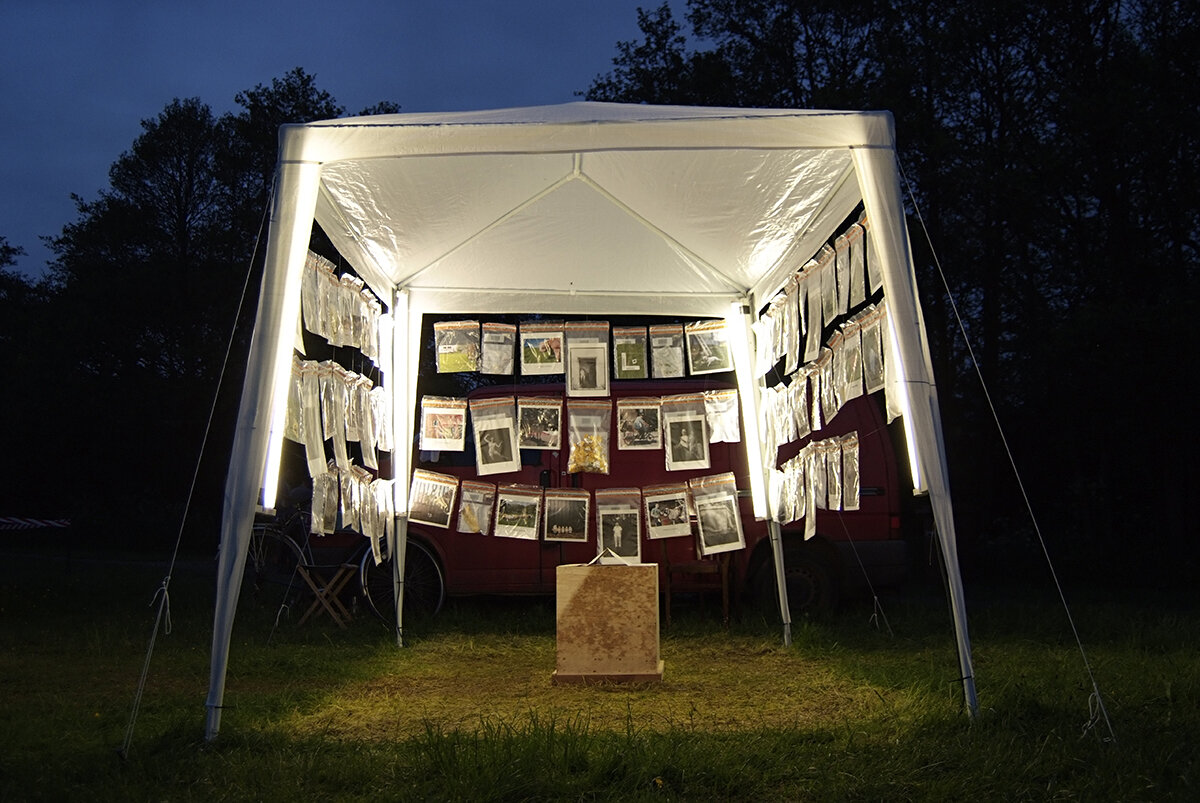Briefly describe the photograph
A very frail, elderly Jewish man sits on the edge of his bed to let me photograph him. This man is a Holocaust survivor from a nearby village.
Where was the photograph made?
This image was taken in Zvenyhorodka, Kyiv Region, Ukraine.
Why was the photograph made?
This image is part of an ongoing project, which I began in January 2017, titled In Search of Amnesia. The project looks into the Jewish narrative in south-east Poland and north-west Ukraine. It is concerned with Jewish memory, how we both remember and forget the past, but it is also a very personal project exploring my own identity and the family story that I hold. Poland and Ukraine are both very culturally and religiously significant to Jews; they are the ancestral home to many diaspora Jews around the world.
In November 2019 I returned to Ukraine for a second time, this time concentrating on the Kiev region. My interest was in meeting the small Jewish communities that had survived the numerous pogroms and the Holocaust. I worked with a guide, Chaim, who drove me to various small towns, some of which had been former shtetls, and still held small Jewish communities. Chaim was more than just a guide: he had been compiling a historical website on the Jewish communities in the Kiev region for the last five or six years, so it was a great opportunity to join him and see the region through his expert eyes.
What was happening outside of the frame?
I am squeezed up against the wall to take this image, so I can get him in the picture frame and include the backdrop of the swan. His wife is in the doorway instructing him to sit down and not to get up, so that I can take his photograph but also because she is worried about him over-exerting himself. Next door his daughter is talking to my guide Chaim about his story as a Jewish survivor of the Holocaust.
Tell us a key fact about this photograph?
The way he is framed by the backdrop of a swooning swan, wings outstretched like a vision of heaven, is particularly relevant as he represents a diminishing population of Jewish people in the rural Kiev region.
Why is this photograph important to you?
To have the opportunity to travel to Ukraine and to be allowed into this man's home, in what was quite an intrusive if consensual manner, was a huge honour. This image represents a much wider narrative about survival and loss, remembering and forgetting, which I could only fully understand by actually visiting these communities and meeting these people.




















































































































![02 14-04-05 [12.36h 43].jpg](https://images.squarespace-cdn.com/content/v1/564da640e4b06d1c92c1a9f1/1604132510712-BN8XVU1J69RFLCY6QPQW/02+14-04-05+%5B12.36h+43%5D.jpg)
![03 14-03-28 [14.42h 54].jpg](https://images.squarespace-cdn.com/content/v1/564da640e4b06d1c92c1a9f1/1604132538356-72GN9CE3NX66XHH24V48/03+14-03-28+%5B14.42h+54%5D.jpg)
![04 14-03-28 [13.16h 45].jpg](https://images.squarespace-cdn.com/content/v1/564da640e4b06d1c92c1a9f1/1604132563424-X6Z0CM3CQJX6DOUQT054/04+14-03-28+%5B13.16h+45%5D.jpg)
![10 14-04-05 [16.23h 39].jpg](https://images.squarespace-cdn.com/content/v1/564da640e4b06d1c92c1a9f1/1604132589898-2CSSX7RM2FO7GJ9P37DZ/10+14-04-05+%5B16.23h+39%5D.jpg)
![17 14-11-07 [13.05h 18].jpg](https://images.squarespace-cdn.com/content/v1/564da640e4b06d1c92c1a9f1/1604132620227-C52KWD2WNJWECC925R6M/17+14-11-07+%5B13.05h+18%5D.jpg)
![25 15-10-20 [14.12h 57].jpg](https://images.squarespace-cdn.com/content/v1/564da640e4b06d1c92c1a9f1/1604132650467-FK8T14PTKD7P5EAX1YGP/25+15-10-20+%5B14.12h+57%5D.jpg)
![40 15-10-23 [13.12h 43].jpg](https://images.squarespace-cdn.com/content/v1/564da640e4b06d1c92c1a9f1/1604132681918-HKQU2H47JORVT45ULR7J/40+15-10-23+%5B13.12h+43%5D.jpg)




![66 15-02-22 [11.21h 26].jpg](https://images.squarespace-cdn.com/content/v1/564da640e4b06d1c92c1a9f1/1604132789147-28G19IOGJUXLBT2S681O/66+15-02-22+%5B11.21h+26%5D.jpg)










![Nat Wilkins, from the Wideyed project Agri[culture]](https://images.squarespace-cdn.com/content/v1/564da640e4b06d1c92c1a9f1/1606234378082-FJFDV8PJUZ7IKE6FNVY3/Agri%5Bculture%5D_NatWilkins_Wideyed.jpg)
















![Louise Taylor, from the Wideyed project Agri[culture]](https://images.squarespace-cdn.com/content/v1/564da640e4b06d1c92c1a9f1/1606234255737-X4BQHF8UN58Q98XFLLEO/Agri%5Bculture%5D_LouiseTaylor_Wideyed.jpg)
![Lucy Carolan, from the Wideyed project Agri[culture]](https://images.squarespace-cdn.com/content/v1/564da640e4b06d1c92c1a9f1/1606234287601-P4XZ8AZKOX6U0ZZYD4KZ/Agri%5Bculture%5D_LucyCarolan_Wideyed.jpg)
![Richard Glynn, from the Wideyed project Agri[culture]](https://images.squarespace-cdn.com/content/v1/564da640e4b06d1c92c1a9f1/1606234347041-5MFIVFK43OADZVABORTW/Agri%5Bculture%5D_RichardGlynn_Wideyed.jpg)
![Nat Wilkins, from the Wideyed project Agri[culture]](https://images.squarespace-cdn.com/content/v1/564da640e4b06d1c92c1a9f1/1606234321821-PCC7R44RSF4YK3GG1GQ4/Agri%5Bculture%5D_NatWilkins_Wideyed2.jpg)
![Agri[Culture] Wideyed installation3.jpg](https://images.squarespace-cdn.com/content/v1/564da640e4b06d1c92c1a9f1/1606234017902-PZMZ9FJ9QJP638IWH7VA/Agri%5BCulture%5D+Wideyed+installation3.jpg)
![Agri[Culture] Wideyed installation4.jpg](https://images.squarespace-cdn.com/content/v1/564da640e4b06d1c92c1a9f1/1606234021369-KPOCLJ9RC42820R1DRGI/Agri%5BCulture%5D+Wideyed+installation4.jpg)
![Agri[Culture] Wideyed installation2.jpg](https://images.squarespace-cdn.com/content/v1/564da640e4b06d1c92c1a9f1/1606233988250-QT09GOSFHGHQ3S8SHE0R/Agri%5BCulture%5D+Wideyed+installation2.jpg)
![Agri[Culture] Wideyed installation.jpg](https://images.squarespace-cdn.com/content/v1/564da640e4b06d1c92c1a9f1/1606233998877-NXEOES22DOBP3MH9K76K/Agri%5BCulture%5D+Wideyed+installation.jpg)



![Agri[culture] Wideyed Publication.jpg](https://images.squarespace-cdn.com/content/v1/564da640e4b06d1c92c1a9f1/1606235815443-DDXD8M4MY48AV82BFBD8/Agri%5Bculture%5D+Wideyed+Publication.jpg)



























































